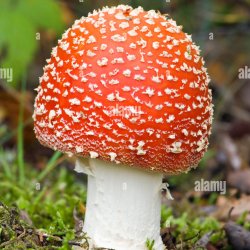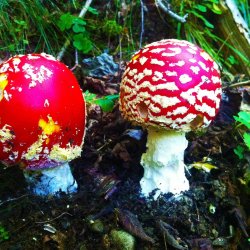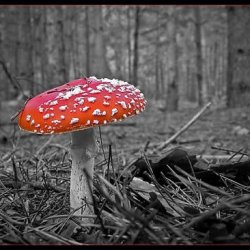FAIRY CAPS UNVEILED: ARE AMANITA MUSCARIA TRULY PSYCHEDELIC?

Amanita Muscaria, commonly known as the Fairy Cap mushroom, has long captivated the human imagination with its vibrant colors and enigmatic allure. But amongst the ethereal tales and folklore, there lies a question that has puzzled scientists and enthusiasts alike: Are Amanita Muscaria truly psychedelic? In recent years, researchers have delved into this enigma, seeking to unravel the mysteries behind this iconic fungi’s mind-altering potential.
Numerous studies and a recent analysis have examined the effects of Amanita Muscaria, aiming to shed light on its psychedelic properties. While it is undeniable that this mushroom contains compounds with psychoactive properties, it is important to note that its psychedelic effects differ from those typically associated with the likes of psilocybin mushrooms or LSD. Rather than inducing vivid hallucinations and visual distortions, Amanita Muscaria initiates a unique and often introspective experience, characterized by a shift in perception, deep contemplation, and altered states of consciousness.
This research has revealed that the primary psychedelic compound in Amanita Muscaria is muscimol. However, its effects are well-documented as being more sedative and dream-like rather than outright hallucinogenic. Some describe a sense of euphoria, enhanced creativity, and a heightened spiritual connection. Yet, caution must be exercised, as consuming Amanita Muscaria without proper preparation and understanding can lead to uncomfortable side effects such as dizziness, delirium, and nausea.
As the understanding of Amanita Muscaria’s psychedelic potential continues to evolve, studies on the topic continue to deepen our knowledge. While it may not fit the conventional mold of what constitutes a psychedelic experience, the allure and curiosity surrounding the Fairy Cap mushroom persist. As with any substance of this nature, it is essential to approach it with respect, caution, and the guidance of trusted experts to fully grasp its complexities and unlock its transformative potential.
Amanita Muscaria: A Controversial Psychedelic Mushroom
Amanita Muscaria, also known as the Fly Agaric, has long captured the fascination of individuals seeking altered states of consciousness. This distinctive bright red mushroom, often depicted in fairy tales and folklore, has been a subject of debate when it comes to its psychedelic properties.
Traditionally used in ceremonial rituals by indigenous cultures worldwide, Amanita Muscaria is believed to induce hallucinogenic experiences. However, recent research has shed light on the complexity of its effects and challenged its classification as a conventional psychedelic.
Studies on the topic have revealed that the psychedelic effects of Amanita Muscaria are not solely attributed to the presence of the compound psilocybin, commonly found in more well-known psychedelic mushrooms. Instead, the mushroom contains various psychoactive compounds, including ibotenic acid and muscimol, which interact with the brain in unique ways.
These findings have led to a recent analysis suggesting that Amanita Muscaria may produce effects that differ from those traditionally associated with psychedelics. Its reported psychedelic experiences often involve dream-like states, heightened sensory perceptions, and a sense of detachment from reality, distinct from the intense visual and emotional alterations typically associated with psychedelics.
In conclusion, while Amanita Muscaria exhibits psychedelic properties, its effects differ from those commonly associated with psychedelic mushrooms. The presence of ibotenic acid and muscimol in this fungus sets it apart, resulting in experiences that may not conform to the traditional understanding of psychedelics. Further studies are needed to fully comprehend the intricacies of this remarkable mushroom and its potential benefits in different contexts.

The Psychedelic Effects of Amanita Muscaria: Debunking the Myths
Amanita Muscaria, commonly known as the fly agaric, has long fascinated people with its vibrant red cap and white spots. It has often been associated with psychedelic experiences, but are these claims truly accurate?
Contrary to popular belief, Amanita Muscaria is not considered psychedelic in the traditional sense. While it does contain psychoactive compounds, the effects it produces are different from those typically associated with psychedelic mushrooms.
Recent research and studies on the topic have shed light on the true nature of Amanita Muscaria’s effects. One of its main psychoactive compounds is muscimol, which is responsible for its unique properties. Muscimol acts primarily as a sedative and hallucinogen, inducing feelings of relaxation and dream-like states rather than intense visual hallucinations often seen with other psychedelics.
A recent analysis of the effects of Amanita Muscaria suggests that yellow varieties of the mushroom may have a stronger psychedelic potential compared to the traditional red ones. However, it is important to note that the psychedelic effects experienced from Amanita Muscaria are highly unpredictable and can vary greatly from person to person.
In conclusion, while Amanita Muscaria does possess psychoactive compounds, it is not considered a traditional psychedelic. Its effects are more sedative and dream-like in nature, rather than the intense visuals commonly associated with psychedelic experiences. Further studies on this fascinating mushroom may provide clearer insights into its potential benefits and risks.
Recent Research and Analysis on Amanita Muscaria’s Psychedelic Properties
Studies and research conducted in recent years have shed new light on the psychedelic properties of Amanita Muscaria, also known as the Fairy Cap mushroom. Scientists and experts have delved into understanding the effects of this intriguing fungus, aiming to determine whether it truly possesses psychedelic properties.
One particular area of interest has been the psychedelic effects reported by individuals who have consumed Amanita Muscaria. These effects are often described as dream-like or trance-inducing, leading to altered states of consciousness. Despite these subjective accounts, scientific analysis has revealed that the primary psychoactive compounds found in Amanita Muscaria, such as muscimol and ibotenic acid, differ from the typical hallucinogens associated with psychedelic mushrooms.
In a recent analysis, researchers have suggested that while Amanita Muscaria does exhibit certain psychedelic qualities, they are unique and distinct from those of other psychedelic mushrooms. The yellow coloration of some variants of Amanita Muscaria has attracted attention, as it has been postulated that these yellow specimens may possess stronger psychedelic properties. However, further studies are needed to confirm this hypothesis.
Thus, recent research and analysis on the topic indicate that Amanita Muscaria does exhibit psychedelic properties, albeit in a different manner than traditionally recognized. The findings challenge conventional notions of psychedelics and highlight the need for continued exploration and understanding of this enigmatic mushroom.





